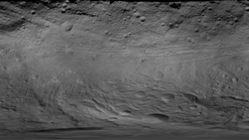Early dawn sheds light on Vesta
Early dawn sheds light on Vesta
Geoscientist 22.06 July 2012

Initial results of the Dawn mission to Vesta (diameter 530 km) and Ceres (a dwarf planet) have been published
1. Vesta, now visited, has revealed a huge circular 475km diameter negative structure centred on the south pole with a central peak ~23km high (greater than Olympus Mons volcano on Mars!).
The structure, named Rheasilva (after a vestal virgin), is thought by the authors to be an impact structure and occupies ~80% of the diameter of the asteroid. I regard this as doubtful: firstly, such a huge impact would surely have blown Vesta apart, and I personally doubt whether Mare Imbrium, likely analogous on the Moon, and with no central peak, is an impact structure. I personally think both are more likely to be endogenous structures.
Picture : False colour map of the south pole of Vesta. -22km is blue to +17 km red to white from mean elevation.
A unique feature is a series of equatorial 10km-wide trough-and-ridge girdles, a completely novel type of structure on a solar system body, and believed to relate to Rheasilva. The asteroid is heavily cratered and there is a multitude of small, fresh bowls, later than the girdles (all likely contemporary) as well as a few older craters. Several of the larger bowl craters have small central craters within.
 Picture:
Picture: The large trough and ridge structures in Vesta’s equatorial region. Image credit, both: NASA/JPL-Caltech/UCLA/MPS/DLR/IDA
Vesta is widely believed to be a mixture of the HED meteorite types: eucrite (basaltic), diogenite (ultramafic, almost monomineralic with bronzite) and howardite (a brecciated mixture of the two). Radiometric dating has constrained these achondrite meteorites’ differentiation to a few hundred million years after the first condensates of our solar system. These determinations of the likely meteoritic analogues stem mainly from spectrography and geochemical modelling.
The evidence from Dawn indicates that Rheasilva exposes mainly ultramafic rocks, supporting the idea that diogenites form the lower crust. The remainder of the crust seems to be enriched in basaltic rocks and may well expose mainly eucrite and howardite. However, until samples are recovered from the surface, there is no certainty of these attributions, and there may be surprises! Spectrographic determinations do not establish the exact mineralogy and modelling may always miss the mark because of the wrong initial input? At time of writing Dawn is going to go closer to Vesta and obtain close up images, before it moves on to the larger Ceres.
Joe McCall
Reference
- Corrigan, C, Beck, A, McCoy, T 2012 Missions to asteroids: journeying to the beginning of our solar system. Elements 8(1), 9-10.